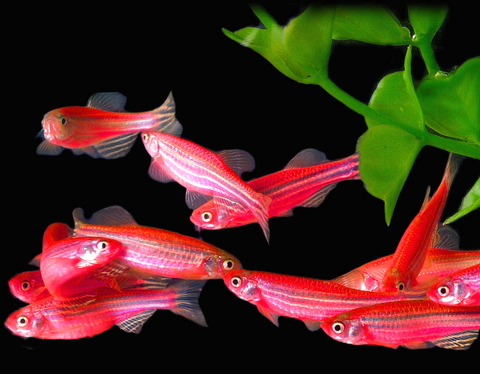Stem cell therapy has long captured the limelight as a way to the goal of regenerative medicine, repairing the body with its own natural systems. But a few scientists believe another path to regener-ative medicine may be as likely to succeed, because it is the solution that nature itself has developed for repairing damaged limbs or organs in a wide variety of animals.
Many species, notably amphi-bians and certain fish, can regenerate a wide variety of body parts. The salamander can regrow its limbs, tail, jaws, the lens and retina of its eye, and its intestine. The zebra fish will regrow fins, scales, spinal cord and part of its heart.
Mammals, too, can renew damaged body parts. All, including humans, can regenerate the liver. Deer regrow their antlers, some at the rate of two centimeters a day, said to be the fastest rate of organ growth in animals. In many of these cases, regeneration begins when the mature cells at the site of a wound start to revert to an immature state. The clump of immature cells, known as a blastema, regrows the missing part, perhaps by tapping into the embryogenesis program that first formed the animal.

PHOTOS: AGENCIES
Initiation of a blastema and the formation of the embryo are obviously separate biological programs, but "the processes must converge at some point," said Jeremy Brockes, a regeneration researcher at University College London.
The blastema seems to derive its instructions from the wound-site cells from which it was formed and is impervious to cues from new surrounding tissue if it is trans-planted. If a blastema made by sectioning a salamander's limb at the wrist is transplanted elsewhere in the body, it will still grow just a wrist and paw, while a shoulder blastema will regrow the whole limb. People, of course, cannot regrow their limbs like newts, and do not form blastemas, so the relevance of regeneration to medicine has seemed remote. But the capacity for regeneration exists in such a wide variety of species that it is unlikely to have evolved independently in each, regeneration researchers believe. Rather, they say, the machinery for regeneration must be a basic part of genetic equipment, but the genes have fallen into disuse in many species.
Disused genes

In support of this notion, people are not wholly lacking in regenerative powers. There are reports that the tip of the finger can occasionally be regenerated, if the cut is above the last joint. And people can repair damage to the liver. Even after 75 percent has been removed in surgery, the liver regains its original mass in two to three weeks.
It is not certain why other organs and limbs have lost this useful capacity, but perhaps only the liver was damaged often enough during its owner's lifetime to make a repair system worth the cost. The liver can regenerate itself, when all else fails, from stem cells, the versatile cells that produce the mature cells of many organs and tissues. But usually it relies on its own mature cells, which, like those of a blastema, possess a remarkable power to divide and multiply, even though they can restore only the organ's mass, not its original structure.
A more specific reason for thinking regeneration is not a wholly lost ability comes from genes. Last December, Mark Keating, who studies regeneration in zebra fish, identified a gene that is essential for initiating blastema formation when the fish's fin is cut. Both this gene, called fgf20, and another he has found, hsp60, also exist in people, suggesting the genetic basis for regeneration may still be in place even though the body can no longer evoke it.

Keating, at the Novartis Institutes for Biomedical Research in Cambridge, Massachusetts, believes stem cells can ordinarily undertake only very limited repairs of organs like the liver and heart, and the scarring often seen in these tissues is a fallback mechanism put in place when the stem cells' capacities are exceeded.
If the genes that boot up the zebra fish blastema also exist in people but are not switched on, perhaps some drug might goad them into action. Once a blastema had been induced at a wound site in the body, regeneration researchers suggest, it might regrow the missing limb or organ with no further intervention required. "Maybe there are residual abilities that could be enhanced" in mammals, said Shannon Odelberg, a University of Utah researcher who studies regeneration in the newt with the goal of inducing blastemas to form in mammals.
Emerging field
Regeneration is studied in only a few laboratories. It was not even on the agenda of the research planning meeting held last October by the California Institute of Regenerative Medicine, which was dominated by stem cell biologists. One reason for this orphan status is that the animals used by most biologists, like the roundworm, the fruit fly and the mouse, are ones that do not regenerate.
The genetics of regenerating animals, like the salamander, are largely unknown, so the process of regeneration has received little attention from research biologists. But there is a group of vertebrates that can regenerate very successfully, said Brockes. "It would be rather surprising if there weren't some interesting and important lessons one could learn from them."
Keating believes the expense of stem cell therapy, should it work, is a major consideration. Even if the approach works, he said, developing cells for every patient who needs them would be very expensive. Switching on the regenerative process with drugs, should that prove possible, would be cheap by comparison.
Robert Weinberg, a biologist at the Whitehead Institute in Cambridge, said therapeutic regeneration was "decades away" because the cells of animals that regenerate are so different from those of people. But he said there is great hope of taking embryonic stem cells and making them yield primitive adult stem cells that still possess regenerative capability. He placed less confi-dence in using fully mature adult stem cells, which may have lost the ability to build new tissue.
In the light of new knowledge, some stem cell biologists are making more guarded predictions about the imminence of stem cell therapy. Ron McKay, an expert on neural stem cells at the National Institutes of Health, noted that stem cells inserted into the developing brain of a fetal animal "become incorporated in an extraordinary way, as if local cues were controlling their behavior."
But in the adult brain, he said, nothing happens, suggesting that the concept of using stem cells to treat Alzheimer's disease is illusory.
Regeneration and stem cell therapy are promising aspects of regenerative medicine but both are still at the research stage. "I'm very bullish on regenerative medicine," said Keating, alluding to both types. "I think it's going to happen and it will be a revolution, but it will take time. It would be a mistake to oversell it and promise too much too early."

This month the government ordered a one-year block of Xiaohongshu (小紅書) or Rednote, a Chinese social media platform with more than 3 million users in Taiwan. The government pointed to widespread fraud activity on the platform, along with cybersecurity failures. Officials said that they had reached out to the company and asked it to change. However, they received no response. The pro-China parties, the Chinese Nationalist Party (KMT) and Taiwan People’s Party (TPP), immediately swung into action, denouncing the ban as an attack on free speech. This “free speech” claim was then echoed by the People’s Republic of China (PRC),

Exceptions to the rule are sometimes revealing. For a brief few years, there was an emerging ideological split between the Democratic Progressive Party (DPP) and Chinese Nationalist Party (KMT) that appeared to be pushing the DPP in a direction that would be considered more liberal, and the KMT more conservative. In the previous column, “The KMT-DPP’s bureaucrat-led developmental state” (Dec. 11, page 12), we examined how Taiwan’s democratic system developed, and how both the two main parties largely accepted a similar consensus on how Taiwan should be run domestically and did not split along the left-right lines more familiar in

As I finally slid into the warm embrace of the hot, clifftop pool, it was a serene moment of reflection. The sound of the river reflected off the cave walls, the white of our camping lights reflected off the dark, shimmering surface of the water, and I reflected on how fortunate I was to be here. After all, the beautiful walk through narrow canyons that had brought us here had been inaccessible for five years — and will be again soon. The day had started at the Huisun Forest Area (惠蓀林場), at the end of Nantou County Route 80, north and east

Specialty sandwiches loaded with the contents of an entire charcuterie board, overflowing with sauces, creams and all manner of creative add-ons, is perhaps one of the biggest global food trends of this year. From London to New York, lines form down the block for mortadella, burrata, pistachio and more stuffed between slices of fresh sourdough, rye or focaccia. To try the trend in Taipei, Munchies Mafia is for sure the spot — could this be the best sandwich in town? Carlos from Spain and Sergio from Mexico opened this spot just seven months ago. The two met working in the